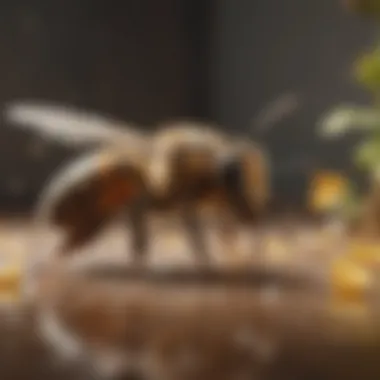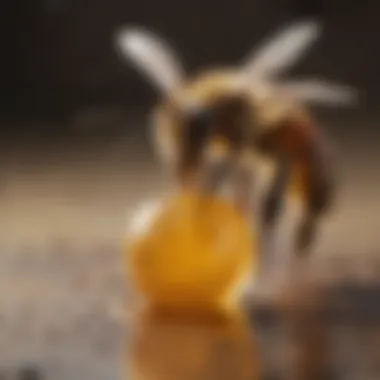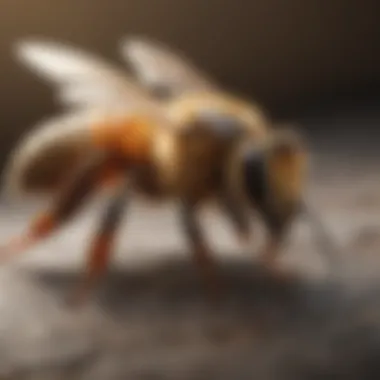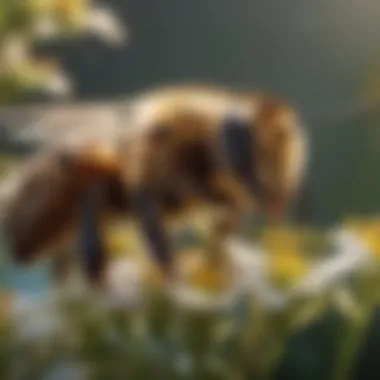Unraveling the Complex World of the Honey Bee: An Intriguing Exploration


Nature Topic Overview
Fun Facts and Trivia
Exploring the realm of the honey bee unveils a trove of captivating facts that are sure to pique the curiosity of young minds. Did you know that honey bees perform a unique 'waggle dance' to communicate the location of food sources to their fellow bees? This fascinating behavior showcases the sophisticated social structure within the hive. Additionally, honey bees are the only insect that produces food consumed by humans, making their role even more extraordinary. Introducing interactive elements such as bee-themed puzzles and visuals can further enhance learning and engagement.
Wildlife Explorations
Amidst the world of honey bees lie various other species that contribute to the vibrant tapestry of nature. From the industrious ants to the graceful butterflies, each creature plays a specialized role in their habitat. Exploring the interconnectedness of these animals and plants offers a deeper appreciation for the delicate balance of ecosystems. Interactive features like quizzes centered around different species and habitat scenarios can help broaden children's understanding of the natural world.
Environmental Awareness
The honey bee's existence is not just intriguing but also crucial for the environment. The pollination work done by bees directly impacts the production of fruits, vegetables, and nuts, making them indispensable to agriculture. Emphasizing the importance of conservation and sustainability in relation to bees can inspire children to actively participate in protecting these vital creatures. Simple tips, such as planting bee-friendly flowers or reducing the use of pesticides, can make a substantial difference in preserving bee populations.
DIY Nature Activities
Encouraging hands-on exploration, creating nature-inspired crafts, and engaging in outdoor activities can nurture a deeper connection with the natural world. Designing a bee-friendly garden, constructing a mini beehive model, or embarking on a bee-themed scavenger hunt are engaging activities that blend education with creativity. Offering step-by-step guides for these DIY projects can empower children to learn actively and implement their newfound knowledge in practical ways.
Introduction to the Honey Bee
The entry point into the fascinating world of the honey bee is crucial for understanding the intricate roles these insects play in the ecosystem. This section serves as a gateway to unravel the mysterious life of honey bees, starting from their evolutionary journey to the modern-day significance they hold in the natural world. Delving deeper into the lives of these tiny pollinators reveals a complex web of behaviors and functions that contribute immensely to the environment.
Evolutionary History
Origins of Honey Bees
Exploring the origins of honey bees sheds light on their remarkable journey through time. The adaptation of these insects to their surroundings, stemming from ancient beginnings, showcases a fascinating tale of resilience and survival. Understanding the nuances of their origin provides a solid foundation for appreciating their current presence and the vital roles they play in our ecosystem.
Adaptations Over Time
Unveiling the adaptations honey bees have undergone over time offers a glimpse into their dynamic evolution. From changes in behavior to physiological adjustments, these adaptations reflect the continuous process of optimization honed through generations. Analyzing these adaptations allows us to grasp the intrinsic connection between honey bees and their ever-changing environment.
Physical Characteristics
Distinct Features
The distinct features of honey bees set them apart as truly remarkable creatures. Their intricate anatomy, including specialized body parts for different functions, showcases the pinnacle of biological efficiency. Exploring these features in detail unravels a world of precision-engineered adaptations that have enabled honey bees to thrive in various habitats.


Morphological Adaptations
The morphological adaptations of honey bees highlight the ingenuity of nature's design. From distinct mouthparts for specific tasks to specialized structures for gathering and processing nectar, every aspect of their morphology serves a vital purpose. Examining these adaptations provides a deeper appreciation for the intricate balance of form and function in the lives of honey bees.
Honey Bee Species
Common Types
Diving into the common types of honey bees offers a glimpse into the rich diversity within this species. Each type, with its unique characteristics and behaviors, contributes uniquely to the overall functioning of the hive. Understanding these common types provides a solid foundation for appreciating the intricate social structures and interactions that drive honey bee colonies.
Diversity in Behavior
Exploring the diversity in behavior among honey bee species reveals the multifaceted nature of these insects. From foraging patterns to communication strategies, each behavior manifests as a vital component of the collective hive intelligence. Analyzing this diversity sheds light on the intricate relationships that underpin the functional unity of honey bee communities.
Social Structure and Roles
The Social Structure and Roles of honey bees are crucial elements in understanding their complex hive dynamics and efficient workflow. Within the hive community, distinct roles are assigned to different categories of bees, including the Queen Bee, Worker Bees, and Drone Bees. Each bee plays a unique and essential role in the functioning of the hive, contributing to tasks allocation and communication methods. The cooperative nature of honey bees exemplifies a sophisticated social structure where division of labor and harmony foster productivity and survival.
The Hive Community
Queen Bee
The Queen Bee holds a pivotal position within the hive hierarchy, responsible for laying eggs and maintaining colony cohesion. Her key characteristic lies in fertility, as she is the sole female capable of reproducing offspring. This aspect of the Queen Bee not only ensures the continuity of the hive but also influences its genetic diversity. Despite her essential role, the Queen Bee's pheromones regulate the behavior of other bees, dictating the overall atmosphere within the colony.
Worker Bees
Worker Bees form the majority of the colony and undertake various tasks essential for hive sustenance. Their key characteristic revolves around diligence and adaptability, enabling them to engage in activities such as foraging, nursing the brood, and hive maintenance. The unique feature of Worker Bees lies in their ability to transition between different roles as needed, showcasing a flexible division of labor. While their hard work drives the hive's functionality, Worker Bees also communicate vital information through dances and pheromones, ensuring smooth workflow.
Drone Bees
Drone Bees represent the male population in the hive, focusing solely on reproduction. Their key characteristic centers on mating with virgin queens from other colonies to diversify genetic pool. While lacking stingers for defense or pollen collection abilities, Drone Bees serve a critical role in ensuring mating success and colony expansion. The unique feature of Drone Bees lies in their singular purpose and evolutionary adaptation towards reproductive efficiency, highlighting the strategic balance of roles within the hive.
Division of Labor
Tasks Allocation
Tasks Allocation is a fundamental component of honey bee operations, ensuring that various responsibilities are distributed efficiently among worker bees. The key characteristic of Tasks Allocation lies in its adaptive nature, allowing bees to prioritize urgent tasks based on colony needs. This aspect enhances productivity and hive function by enabling bees to address immediate requirements such as brood care or food storage. While Tasks Allocation optimizes resource utilization, it also demonstrates the strategic planning inherent in honey bee social structure.
Efficient Workflow


Efficient Workflow underscores the seamless coordination and communication within the hive community, influencing the division of labor and overall productivity. The key characteristic of Efficient Workflow is its focus on task optimization and resource management, streamlining collective efforts towards common goals. This feature enables bees to synchronize their activities through signaling methods, promoting synergy and maximizing output. Despite variations in individual capabilities, Efficient Workflow ensures a harmonious balance of tasks within the hive, highlighting the adaptive nature of honey bee communities.
Communication Methods
Dances
Dances are intricate communication methods employed by bees to convey crucial information regarding food sources, hive locations, and environmental cues. The key characteristic of Dances lies in their symbolic nature, with different dance patterns representing distinct messages. Through intricate movements and vibrations, bees share valuable coordinates and quality assessments, guiding fellow workers towards profitable foraging sites. This unique feature of Dances facilitates efficient resource utilization and collective decision-making, enhancing the foraging success of the entire colony.
Pheromones
Pheromones play a significant role in honey bee communication, serving as chemical signals that influence behavior and social interactions. The key characteristic of Pheromones is their ability to transmit information efficiently across the hive, eliciting coordinated responses from other bees. By releasing specific pheromones, bees can indicate alarm, food availability, or queen presence, triggering appropriate reactions within the colony. This unique feature of Pheromones fosters rapid information dissemination, contributing to hive cohesion and coordination in various activities.
Foraging Behavior and Pollination
The section on foraging behavior and pollination in this article delves into the crucial aspects of a honey bee's life cycle, shedding light on their pivotal role in pollination and ecosystem sustainability. Understanding the intricate mechanisms behind a honey bee's foraging behavior is key to appreciating the interconnectedness of nature. From navigating vast landscapes to selective flower choices, these tiny yet efficient pollinators play a monumental role in maintaining floral biodiversity and ensuring food production for various ecosystems worldwide.
Navigation Techniques
Sun Compass Orientation
Embarking on a journey to unravel the mysteries of a honey bee's navigation skills leads us to the intriguing concept of Sun Compass Orientation. This specialized ability allows honey bees to determine direction based on the sun's position, showcasing their remarkable adaptability and evolutionary prowess. The inherent accuracy of Sun Compass Orientation serves as a fundamental tool for bees to locate food sources efficiently, contributing to their overall survival within dynamic environments. Despite its simplicity, this technique remains a hallmark of a honey bee's navigation arsenal, highlighting the resilience and precision ingrained in their daily routines.
Landmarks Detection
In the realm of a honey bee's foraging expedition, the skill of Landmarks Detection emerges as a critical component in their navigational strategies. By recognizing distinctive landmarks within their surroundings, honey bees establish mental maps that aid in successful food source relocation and hive return. The ability to detect and utilize landmarks reflects the cognitive depth within these industrious insects, showcasing the intricate intelligence governing their daily interactions. While reliant on memory and visual cues, Landmarks Detection underscores the resourcefulness and adaptability prevalent in a honey bee's foraging behavior, amplifying their efficiency and survival rates.
Nectar Collection
Flower Selection
The art of Flower Selection stands as a refined practice embedded in a honey bee's foraging routine, where the choice of floral sources significantly influences nutrient intake and hive productivity. Through a meticulous selection process, bees exhibit a preference for specific flower types based on factors like nectar concentration, accessibility, and blooming stages. This selective behavior unveils the nuanced decision-making capacity within honey bees, showcasing their ability to optimize resource acquisition while ensuring colony sustenance and growth. The intricate dance between bees and flowers epitomizes a harmonious relationship built on mutual benefit and ecological stability, underscoring the intricate balance within natural ecosystems.
Syrup Processing
Within the bustling world of a honey bee hive, Syrup Processing emerges as a vital stage in the nectar-to-honey transformation journey. Bees meticulously process collected nectar through enzymatic reactions and dehydration processes, converting it into the beloved golden syrup renowned for its nutritional value and longevity. The intricate steps involved in syrup processing showcase the collective effort and specialized roles within a hive, emphasizing collaboration and efficiency in honey production. Despite the laborious nature of this process, bees masterfully navigate the complexities of syrup processing, underscoring their organizational prowess and resilience amidst changing environmental conditions.
Crucial Role in Pollination


Ecosystem Impact
The impact of honey bees on ecosystems reverberates far beyond their immediate surroundings, with their pollination services fostering biodiversity and ecological stability. By transferring pollen from flower to flower, bees catalyze plant reproduction, supporting floral diversity and genetic resilience within habitats. The interconnected web of pollination underscores the intricate relationships between bees, flora, and fauna, weaving a tapestry of symbiotic dependencies essential for ecosystem health. The ripple effect of a honey bee's ecosystem impact underscores the profound significance of their pollination efforts, shaping landscapes and sustaining life cycles with meticulous precision.
Food Production
In the realm of agriculture and food security, honey bees reign as unsung heroes, driving the wheels of global food production through their pollination services. By facilitating the growth of various crops, fruits, and vegetables, bees ensure bountiful harvests and nutritional abundance for human populations worldwide. The role of bees in food production transcends mere pollination, extending to agricultural sustainability and economic prosperity. Their tireless foraging endeavors and pollination contributions epitomize a silent yet monumental force shaping the world's agricultural landscapes and culinary diversity.
Challenges and Conservation Efforts
When examining the intricate life of a honey bee, it becomes apparent that understanding the challenges they face and efforts towards their conservation are paramount. The delicate balance of nature relies heavily on these tiny creatures, making it crucial to address the threats looming over their existence. This section will shed light on the importance of implementing conservation measures and resilient strategies to safeguard the honey bee population.
Threats to Honey Bees
Pesticide Use
Pesticide use poses a significant threat to honey bees, disrupting their natural habitat and foraging patterns. The indiscriminate application of pesticides results in the contamination of nectar and pollen sources, endangering the health of bee colonies. Furthermore, the persistence of certain pesticides in the environment leads to long-term repercussions on bee populations, ultimately affecting crop pollination and ecosystem balance.
Climate Change Effects
The effects of climate change reverberate through the delicate ecosystem that honey bees inhabit. Shifts in temperature and weather patterns alter floral bloom cycles, impacting the availability of nectar and pollen. This disruption in resource availability escalates competition among pollinators and compromises the overall health of bee communities. Adapting to these changing environmental conditions is essential to mitigate the adverse effects of climate change on honey bee populations.
Importance of Conservation
Conservation efforts play a pivotal role in preserving honey bee populations and maintaining ecological stability. Emphasizing the importance of conserving these vital pollinators is not just a choice but a necessity to sustain biodiversity and food production.
Ecosystem Stability
Ensuring ecosystem stability is key to safeguarding the intricate web of interactions that support honey bee colonies. By conserving natural habitats and promoting biodiversity, ecosystem stability not only benefits honey bees but also contributes to the resilience of entire ecosystems. Maintaining a balance in the environment allows honey bees to flourish and fulfill their crucial role in pollination.
Beekeeping Practices
Integrating sustainable beekeeping practices is essential for supporting honey bee populations while ensuring a sustainable supply of hive products. Proper hive management techniques, disease prevention strategies, and responsible beekeeping practices contribute to maintaining healthy bee colonies. By upholding ethical standards in beekeeping, individuals can actively participate in the conservation of honey bees and their habitats.
Research and Initiatives
Ongoing scientific studies and community involvement are pivotal in advancing our understanding of honey bee behavior and ecosystem dynamics.
Scientific Studies
In-depth scientific studies provide valuable insights into the behavior, biology, and ecological impact of honey bees. By conducting rigorous experiments and observations, researchers uncover underlying mechanisms that drive pollination efficiencies and hive health. These studies not only inform conservation strategies but also foster innovation in sustainable agricultural practices.
Community Involvement
Engaging the community in conservation initiatives fosters a sense of stewardship towards honey bees and their environment. By educating the public on the importance of pollinators and promoting habitat preservation, community involvement acts as a catalyst for change. Empowering individuals to take action in supporting honey bee populations cultivates a collective responsibility towards environmental sustainability.







